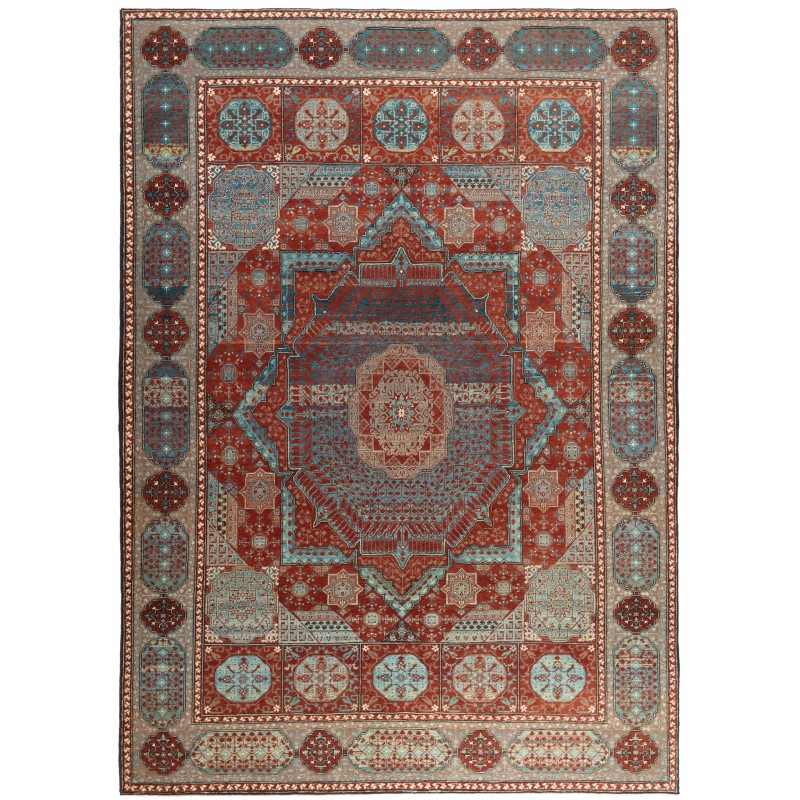
- Stock: In Stock
- Model: C50374
- サイズ: 205cm x 285cm
この絨毯の情報源は、ウォルター・B・デニー著「イスラム絨毯の読み方」、メトロポリタン美術館、ニューヨーク、2014年の図版61、62から得られています。この五つ星メダリオン絨毯は、エジプトのカイロのマムルークスルタンによって16世紀初頭にデザインされました。ニューヨークのメトロポリタン美術館に「シモネッティ」絨毯として展示されています。イスラムの絨毯には、見つかった場所にちなんで名づけることが一般的です(「ニイデ絨毯」)または以前の所有者にちなんで名づけることがあります(「アンハルト絨毯」)。この場合、イタリア人の前所有者であるシモネッティが、15世紀のカイロのブルジ・マムルーク王朝(1382年-1517年)の織物の優れた例を記念して名づけられました。シモネッティ絨毯は、そのカラーパレットから通常「五色マムルーク絨毯」と呼ばれています。材料(特にS撚り、または時計回りの撚りを持つウール)、染料(ラック虫から作られた紫赤を含む限られた範囲の色)、および特徴的な幾何学的デザインのレパートリーは、この時期のマムルーク絨毯の特徴です。幅は約94インチ(239cm)で、カイロで織られた当時の絨毯としては典型的なサイズです。絨毯はローラーバーロームを使用して作られました。未織の経糸は織機の上部にある回転する木製の円柱状のローラーから巻き出され、完成した絨毯は同様のローラーに巻き上げられました。この方法により、同じ織機で非常に長い絨毯と比較的短い絨毯を同じ幅で織ることができました。シモネッティ絨毯は、通常、短いマムルーク絨毯で見られる3つの幾何学的なメダリオンデザイン(そのうち2つが繰り返され、A-B-C-B-Aの順序で組み合わされる)を、非常に長く印象的な作品に組み込んでいます。
マムルーク絨毯は、イスラム世界の多くの絨毯織地に共通して存在する、豊かな周縁の牧草地と温暖な気候に恵まれない環境で生まれました。北のアナトリアに中心を置くトルコの織物の広範な伝統と関連していますが、これらの絨毯のデザインには、エジプトの伝統に根ざした、パピルス植物のようにスタイリズされた要素など、非典型的な要素も含まれています。彼らの異例な構成とレイアウトは、おそらく「マムルークブランド」を利益の上がるヨーロッパの輸出市場で確立することができる特徴的な製品を開発しようとする試みを表しています。特徴的な色合いは、未染の白いパイルを欠き、同じ価値を持つ3色または5色の範囲を使用するという点でも、特定のスタイルのアイデンティティを創造しようとする意図的な試みを示唆しています。また、イスラム絨毯の世界ではほとんど唯一の存在であるS撚りウールも特筆すべきです。エジプトで時計回りにウールを撚る伝統は、以前のエジプトの亜麻をリネン糸に撚る伝統によるものだと主張されています。植物の植物学的構造の詳細からみて、亜麻繊維を中東全体で一般的な反時計回りの方向で撚ることは不可能ですが、エジプトで行われるようになったとされています。
シモネッティに見られるような色の組み合わせを持つマムルーク絨毯は、現在では一般的にアナトリア、イラン、シリアの織物に多くのリンクを持つ以前の伝統の一部として認識されています。メトロポリタン美術館のコレクションによく見られる「三色」のマムルーク絨毯は、1517年のエジプトのオスマン帝国による征服後も続いた後の発展を表しています。そのような絨毯は、おそらく17世紀に入っても多く生産され、さらに遅くまで生産された可能性があります(ウォルター・B・デニー、エフティアール、スーチェック、キャンビー、ハイダー、2011年)。私たちのデザイナーによって解釈されたこの絨毯のデザインには、中央に一つの星があり、柔らかな色が使用されています。
The source of carpet comes from the book How to Read – Islamic Carpets, Walter B. Denny, The Metropolitan Museum of Art, New York 2014 fig.61,62. The five-star-medallion carpet was designed in the early 16th century by Mamluk Sultane of Cairo, Egypt. It is exhibited at The Metropolitan Museum of Art, New York as The ‘Simonetti’ Carpet. The conventional practice of naming Islamic carpets either after the place they were found (“Niğde Carpet”) or after a previous owner (“Anhalt Carpet”) in this case memorializes the former Italian owner of this magnificent example of fifteenth-century Cairene weaving under the Burji Mamluk dynasty (1382–1517). The Simonetti Carpet is commonly called a “five-color Mamluk carpet” because of its color palette. The materials (most notably S-spun, or clockwise-spun, wool), dyestuffs (a limited range of colors including a purple-red made from the lac insect), and distinctive repertoire of geometric designs are all characteristic of Mamluk carpets from the period. The width, about ninety-four inches (239 cm), is typical for contemporaneous carpets woven in Cairo. A roller-bar loom was used to make the carpet: the unwoven warps were unwound from a rotating cylindrical wood roller at the top of the loom, and the finished carpet was then wound up around a similar roller at the bottom. This method allowed the same loom to be employed to weave both very long and relatively short carpets of the same width. The Simonetti displays three of the geometric medallion designs usually seen in short Mamluk carpets (two of them repeated, combined in A-B-C-B-A sequence) in one very long, impressive work of art.
Mamluk carpets originated in a physical environment that lacked the combination of abundant marginal grazing land and a temperate climate with cool winters that were common to most carpet-weaving areas in the Islamic world. While related to a broader tradition of Turkish weaving centered in Anatolia, far to the north, the designs of these carpets include atypical elements, such as stylized papyrus plants, that are deeply rooted in Egyptian tradition. Their unusual composition and layout probably represent an attempt to develop a distinctive product that could in effect establish a “Mamluk brand” in the lucrative European export market. The uncharacteristic color scheme—devoid of the undyed white pile and employing a limited range of three or five hues in much the same value—also suggests a conscious attempt to create a particular stylistic identity. Also virtually unique in the world of Islamic carpets is the S-spun wool. It has been argued that the tradition of clockwise wool spinning originated in Egypt because of the earlier Egyptian tradition of spinning flax into linen thread. Details of the plant’s botanical structure make it impossible to spin flax fiber in the more common counterclockwise direction utilized throughout the Middle East for wool and cotton.
Mamluk carpets with the color combinations seen in the Simonetti are now generally accepted as part of an earlier tradition that has many links to the weaving of Anatolia, Iran, and Syria. The “three-color” Mamluk carpets, well represented in the Metropolitan’s collection, represent a later development that continued well after the Ottoman conquest of Egypt in 1517. Many such carpets may have been produced well into the seventeenth century, and possibly even later. (Walter B. Denny in [Ekhtiar, Soucek, Canby, and Haidar 2011]). The design of the rug is interpreted by our designers with one central star, and soft colors are used for this rug.
